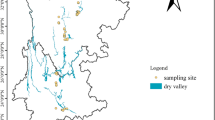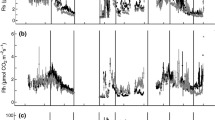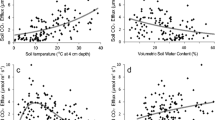Abstract
Based on macroecological data, we test the hypothesis whether European tree species of temperate and boreal distribution maintain their water and nutrient supply in the more arid southern margin of their distribution range by shifting to more fertile soils with higher water storage than in their humid core distribution range (cf. soil compensatory effects). To answer this question, we gathered a large dataset with more than 200,000 plots that we related to summer aridity (SA), derived from WorldClim data, as well as soil available water capacity (AWC) and soil nutrient status, derived from the European soil database. The soil compensatory effects on tree species distribution were tested through generalized additive models. The hypothesis of soil compensatory effects on tree species distribution under limiting aridity was supported in terms of statistical significance and plausibility. Compared to a bioclimatic baseline model, inclusion of soil variables systematically improved the models’ goodness of fit. However, the relevance measured as the gain in predictive performance was small, with largest improvements for P. sylvestris, Q. petraea and A. alba. All studied species, except P. sylvestris, preferred high AWC under high SA. For F. sylvatica, P. abies and Q. petraea, the compensatory effect of soil AWC under high SA was even more pronounced on acidic soils. Soil compensatory effects might have decisive implications for tree species redistribution and forest management strategies under anthropogenic climate change. Therefore, soil compensatory effects deserve more intensive investigation, ideally, in studies combining different spatial scales to reduce the uncertainty associated with the precision of soil information.



Similar content being viewed by others
Abbreviations
- AWC:
-
Available water capacity
- DTOL:
-
Tolerances to drought
- EQ:
-
Ellenberg’s climate quotient
- EQm:
-
Modified EQ
- ESDB:
-
European soil database
- LogEQm:
-
Decimal logarithm from EQm
- RSC:
-
Relative site constancy
- SA:
-
Summer aridity
- SDM:
-
Species distribution model
- STOL:
-
Tolerances to shade
- SNS:
-
Soil nutrient status
References
Alonso-Ponce R, López Senespleda E, Sánchez Palomares O (2010) A novel application of the ecological field theory to the definition of physiographic and climatic potential areas of forest species. Eur J For Res 129:119–131
Allouche O, Tsoar A, Kadmon R (2006) Assessing the accuracy of species distribution models: prevalence, kappa and the true skill statistic (TSS). J Appl Ecol 43:1223–1232
Attorre F, Alfò M, de Sanctis M et al (2011) Evaluating the effects of climate change on tree species abundance and distribution in the Italian peninsula. Appl Veg Sci 14:242–255
Austin MP (1980) Searching for a model for use in vegetation analysis. Vegetatio 42:11–21
Austin MP, Nicholls AO, Margules CR (1990) Measurement of the realized qualitative niche: environmental niches of five Eucalyptus species. Ecol Monogr 60:161–177
Bailey RG (1987) Suggested hierarchy of criteria for multi-scale ecosystem mapping. Landsc Urb Plan 14:313–319
Barbet-Massin M, Jiguet F, Albert CH et al (2012) Selecting pseudo-absences for species distribution models: how, where and how many? Methods Ecol Evol 3:327–338
Barnes BV, Pregitzer KS, Spies TA et al (1982) Ecological forest site classification. J For 80:493–498
Beauregard F, de Blois S (2014) Beyond a climate-centric view of plant distribution: edaphic variables add value to distribution models. PLoS ONE 9:e92642
Benito-Garzón M, Ruiz-Benito P, Zavala MA (2013) Interspecific differences in tree growth and mortality responses to environmental drivers determine potential species distributional limits in Iberian forests. Global Ecol Biogeogr 22:1141–1151
Bertrand R, Perez V, Gégout J-C (2012) Disregarding the edaphic dimension in species distribution models leads to the omission of crucial spatial information under climate change: the case of Quercus pubescens in France. Glob Change Biol 18:2648–2660
Binkley D, Vitousek P (1989) Soil nutrient availability. In: Pearcy RW, Ehleringer JR, Mooney HA et al (eds) Plant physiological ecology field methods and instrumentation. Springer, Dordrecht, pp 75–96
Blume H-P, Brümmer GW, Fleige H et al (2016) Scheffer/Schachtschabel soil science. Springer, Berlin, Heidelberg
Bohn U, Neuhäusl R, Gollub G, Hettwer C, Neuhäuslova Z, Raus T, Schlüter H, Weber H (2003) Map of the natural vegetation of Europe, scale 1:2500000. Parts 1–3. Landwirtschaftsverlag, Münster-Hiltrup
Bradbury IK, Malcolm DC (1977) The effect of phosphorus and potassium on transpiration, leaf diffusive resistance and water-use efficiency in Sitka spruce (Picea sitchensis) seedlings. J Appl Ecol 14:631–641
Bréda N, Huc R, Granier A et al (2006) Temperate forest trees and stands under severe drought. A review of ecophysiological responses, adaptation processes and long-term consequences. Ann For Sci 63:625–644
Brus DJ, Hengeveld GM, Walvoort DJ et al (2011) Statistical mapping of tree species over Europe. Eur J For Res 131:145–157
Bussotti F, Pollastrini M (2017) Observing climate change impacts on European forests: what works and what does not in ongoing long-term monitoring networks. Front Plant Sci 8:1–5
Cajander AK (1949) Forest types and their significance. Acta For Fennica 56:1–71
Caudullo G, Tinner W, de Rigo D (2016) Picea abies in Europe: distribution, habitat, usage and threats. In: San-Miguel-Ayanz J, de Rigo D, Caudullo G, Houston Durrant T, Mauri A (eds) European atlas of forest tree species. Publ. Off. EU, Luxembourg, p e012300+
Coudun C, Gégout J-C, Piedallu C et al (2006) Soil nutritional factors improve models of plant species distribution. An illustration with Acer campestre (L.) in France. J Biogeogr 33:1750–1763
Czúcz B, Gálhidy L, Mátyás C (2011) Present and forecasted xeric climatic limits of beech and sessile oak distribution at low altitudes in Central Europe. Ann For Sci 68:99–108
Diekmann M, Michaelis J, Pannek A (2015) Know your limits—the need for better data on species responses to soil variables. Basic Appl Ecol 16:563–572
Dolos K, Bauer A, Albrecht S (2015) Site suitability for tree species. Is there a positive relation between a tree species’ occurrence and its growth? Eur J For Res 134:609–621
Dubuis A, Giovanettina S, Pellissier L et al (2013) Improving the prediction of plant species distribution and community composition by adding edaphic to topo-climatic variables. J Veg Sci 24:593–606
Ducousso A, Bordacs S (2004) EUFORGEN technical guidelines for genetic conservation and use for pedunculate and sessile oaks, Quercus robur and Q. petraea. European Forest Genetic Resources Programme, International Plant Genetic Resources Institute, Rome
Dullinger S, Gattringer A, Thuiller W et al (2012) Extinction debt of high-mountain plants under twenty-first-century climate change. Nat Clim Change 2:619–622
Ellenberg H (1988) Vegetation ecology of central Europe. Cambridge University Press, Cambridge
Ellenberg H, Leuschner C (2010) Vegetation Mitteleuropas mit den Alpen. Verlag Eugen Ulmer, Stuttgart
Ewald J, Hédl R (2014) Spatial modeling of vegetation potential: an introduction. Folia Geobot 49:309–312
Falk W, Mellert KH (2011) Species distribution models as a tool for forest management planning under climate change: risk evaluation of Abies alba in Bavaria. J Veg Sci 22:621–634
Falk W, Mellert K, Bachmann-Gigl U et al (2013) Bäume für die Zukunft: baumartenwahl auf wissenschaftlicher Grundlage. LWF aktuell 94:8
Fang J, Lechowicz MJ (2006) Climatic limits for the present distribution of beech (Fagus L.) species in the world. J Biogeogr 33:1804–1819
Fischer R, Lorenz M, Granke O et al Forest condition in Europe: 2010 technical report of ICP forests. Executive Report. ICP Forests and European Commission, Hamburg
Franklin J (2010) Mapping species distributions: spatial inference and prediction. Cambridge University Press, Cambridge
Freeman EA, Moisen G (2008) Presence absence: an R package for presence-absence model analysis. J Stat Softw 23:1–31
Golub GH, Heath M, Wahba G (1979) Generalized cross-validation as a method for choosing a good ridge parameter. Technometrics 21:215–223
Guisan A, Zimmermann NE (2000) Predictive habitat distribution models in ecology. Ecol Model 135:147–186
Halvorsen R (2012) A gradient analytic perspective on distribution modelling. Sommerfeltia 35:1–165
Hanewinkel M, Cullmann DA, Michiels H-G et al (2014) Converting probabilistic tree species range shift projections into meaningful classes for management. J Environ Manag 134:153–165
Hiederer R (2013) Mapping soil properties for Europe—spatial representation of soil database attributes. Publications Office of the European Union. EUR26082EN Scientific and Technical Research series, Luxembourg
Hijmans RJ, van Etten J (2014) Raster: geographic data analysis and modeling. R package vers 2.2–31. https://CRAN.R-project.org/package=raster
Hijmans RJ, Cameron SE, Parra JL et al (2005) Very high resolution interpolated climate surfaces for global land areas. Int J Climatol 25:1965–1978
Hlásny T, Mátyás C, Seidl R et al (2014) Climate change increases the drought risk in Central European forests: what are the options for adaptation? For J 60:5–18
Kölling C, Hoffmann M, Gulder H-J (1996) Bodenchemische Vertikalgradienten als charakteristische zustandsgrössen von waldökosystemen. Z Pflanz Bodenkunde 159:69–77
Kühn I (2007) Incorporating spatial autocorrelation may invert observed patterns. Divers Distrib 13:66–69
Lakatos F, Molnár M (2009) Mass mortality of beech (Fagus sylvatica L.) in South-West Hungary. Acta Silvatica et Lignaria Hungarica 5:75–82
Latron J, Llorens P, Gallart F (2009) The hydrology of Mediterranean mountain areas. Geogr Compass 3:2045–2064
Leibundgut H (1984) Unsere Waldbäume. Eigenschaften und Leben. Huber, Frauenfeld
Lenoir J, Svenning J-C (2015) Climate-related range shifts–a global multidimensional synthesis and new research directions. Ecography 38:15–28
Lenoir J, Svenning J-C, Dullinger S et al (2012) The Alps vegetation database–a geo-referenced community-level archive of all terrestrial plants occurring in the Alps. Biodivers Ecol 4:331–332
Lenoir J, Hattab T, Pierre G (2017) Climatic microrefugia under anthropogenic climate change: implications for species redistribution. Ecography 40:253–266
Leuschner C, Köckemann B, Buschmann H (2009) Abundance, niche breadth, and niche occupation of Central European tree species in the centre and at the margin of their distribution range. For Ecol Manag 258:1248–1259
Ligot G, Balandier P, Fayolle A et al (2013) Height competition between Quercus petraea and Fagus sylvatica natural regeneration in mixed and uneven-aged stands. For Ecol Manag 304:391–398
Liu C, Berry PM, Dawson TP et al (2005) Selecting thresholds of occurrence in the prediction of species distributions. Ecography 28(3):385–393
Lopez-Senespleda E, Montero G (2015) Tipificación Ecológico-Selvícola de las Principales Especies Forestales Españolas, INIA-CIFOR, Final Report, Madrid
Mátyás C, Ackzell L, Samuel CJA (2004) EUFORGEN technical guidelines for genetic conservation and use for Scots pine (Pinus sylvestris). European Forest Genetic Resources Programme, International Plant Genetic Resources Institute, Rome
Mátyás C, Berki I, Czúcz B et al (2010) Future of beech in Southeast Europe from the perspective of evolutionary ecology. Acta Silvatica et Lignaria Hungarica 6:91–110
Meier ES, Kienast F, Pearman PB et al (2010) Biotic and abiotic variables show little redundancy in explaining tree species distributions. Ecography 33:1038–1048
Mellert KH, Ewald J (2014) Nutrient limitation and site-related growth potential of Norway spruce (Picea abies [L.] Karst) in the Bavarian Alps. Eur J For Res 133:433–451
Mellert KH, Göttlein A (2013) Identification and validation of thresholds and limiting nutrient factors of Norway spruce by using new nutritional levels and modern regression. Allg For Jagdztg 184:197–203
Mellert KH, Fensterer V, Küchenhoff H et al (2011) Hypothesis-driven species distribution models for tree species in the Bavarian Alps. J Veg Sci 22:635–646
Mellert KH, Deffner V, Küchenhoff H et al (2015) Modeling sensitivity to climate change and estimating the uncertainty of its impact. A probabilistic concept for risk assessment in forestry. Ecol Model 316:211–216
Mellert KH, Ewald J, Hornstein D et al (2016) Climatic marginality: a new metric for the susceptibility of tree species to warming exemplified by Fagus sylvatica (L.) and Ellenberg’s quotient. Eur J For Res 135:137–152
Michel A, Seidling W, Lorenz M et al (2016) Forest Condition in Europe 2016. ICP Forests and European Commission, Hamburg
Nieto-Lugilde D, Lenoir J, Abdulhak S et al (2015) Tree cover at fine and coarse spatial grains interacts with shade tolerance to shape plant species distributions across the Alps. Ecography 38:578–589
Niinemets Ü, Valladares F (2006) Tolerance to shade, drought, and waterlogging of temperate northern hemisphere trees and shrubs. Ecol Monogr 76:521–547
Panagos P, van Liedekerke M, Jones A et al (2012) European soil data centre: response to European policy support and public data requirements. Land Use Policy 29:329–338
Peterson AT, Soberón J, Pearson RG, Anderson RP, Martínez-Meyer E, Nakamura M, Araúcho MB (2011) Ecological niches and geographic distributions (MPB-49). Princeton University Press
Piedallu C, Gégout J, Perez V et al (2013) Soil water balance performs better than climatic water variables in tree species distribution modelling. Glob Ecol Biogeogr 22:470–482
Piedallu C, Gégout J-C, Lebourgeois F et al (2016) Soil aeration, water deficit, nitrogen availability, acidity and temperature all contribute to shaping tree species distribution in temperate forests. J Veg Sci 27:387–399
R Core Team (2016) R: a language and environment for statistical computing. R Foundation for Statistical Computing, Vienna, Austria
Rasztovits E, Moricz N, Berki I et al (2012) Evaluating the performance of stochastic distribution models for European beech at low-elevation xeric limits. Idojárás 116:173–194
Sánchez De Dios R, Hernández L, Montes F et al (2016) Tracking the leading edge of Fagus sylvatica in North-Western Iberia: holocene migration inertia, forest succession and recent global change. Perspect Plant Ecol 20:11–21
Serra-Diaz JM, Keenan TF, Ninyerola M et al (2013) Geographical patterns of congruence and incongruence between correlative species distribution models and a process-based ecophysiological growth model. J Biogeogr 40:1928–1938
Stojanović DB, Kržič A, Matović B et al (2013) Prediction of the European beech (Fagus sylvatica L.) xeric limit using a regional climate model. An example from southeast Europe. Agr For Meteorol 176:94–103
Swets J (1988) Measuring the accuracy of diagnostic systems. Science 240(4857):1285–1293
Tegel W, Seim A, Hakelberg D et al (2014) A recent growth increase of European beech (Fagus sylvatica L.) at its Mediterranean distribution limit contradicts drought stress. Eur J For Res 133:61–71
Thuiller W (2013) On the importance of edaphic variables to predict plant species distributions—limits and prospects. J Veg Sci 24:591–592
Tsiripidis I, Bergmeier E, Fotiatidis G et al (2012) Hellenic beech forests database (Hell-Beech-DB). Biodivers Ecol 4:390
Walter H (1973) Vegetation of the earth in relation to climate and the eco-physiological conditions. Universities Press, London
Whittaker RH (1970) Communities and ecosystems. Macmillan, London
Wolf H (2003) EUFORGEN technical guidelines for genetic conservation and use for silver fir (Abies alba). European Forest Genetic Resources Programme, International Plant Genetic Resources Institute, Rome
Wood S (2006) Generalized additive models: an introduction with R. CRC Press, Boca Raton
Wood S (2017) Mixed GAM computation vehicle with automatic smoothness estimation. R package vers 1.8–22. https://CRAN.R-project.org/package=mgcv
Zimmermann NE, Jandl R, Hanewinkel M et al (2013) Chapter 4 potential future ranges of tree species in the Alps. In: Cerbu GA, Hanewinkel M, Gerosa G, Jandl R (eds) Management strategies to adapt alpine space forests to climate change risks, InTech, Chapters published August 28, 2013 under CC BY 3.0 license https://doi.org/10.5772/56933
Acknowledgements
This study was funded by the Federal Ministry of Food and Agriculture as well as the Federal Environment Ministry of Germany (project number 28WB4058) and the Bavarian State Forest Administration (project number W42), an authority of the Ministry for Nutrition, Agriculture and Forestry. We acknowledge ICP Forests and the involved country representatives for providing Level-I data. Our thanks also go to Nikolaos Grigoriadis from Greece, Aleksander Marinšek, Alexey Zharov from Germany and Doganay Tolunay from Turkey for data provision. However, the Turkish data could not be used in this analysis, as the ESDB do not contain soil data from this country. Additionally, we are deeply indebted to our colleagues, Solti György, Markus Neumann and Heino Polley for providing us access to the national forest inventories of Hungary, Austria and Germany, respectively, as well as Monika Konnert (Bavarian Institution for Forest Seeding and Planting) for providing data from provenance plots. Furthermore, we thank all other contributors of vegetation databases and other data sources as well as two anonymous reviewers whose comments helped to clarify important issues.
Author information
Authors and Affiliations
Corresponding author
Additional information
Communicated by Agustín Merino.
Electronic supplementary material
Below is the link to the electronic supplementary material.
Rights and permissions
About this article
Cite this article
Mellert, K.H., Lenoir, J., Winter, S. et al. Soil water storage appears to compensate for climatic aridity at the xeric margin of European tree species distribution. Eur J Forest Res 137, 79–92 (2018). https://doi.org/10.1007/s10342-017-1092-x
Received:
Revised:
Accepted:
Published:
Issue Date:
DOI: https://doi.org/10.1007/s10342-017-1092-x




